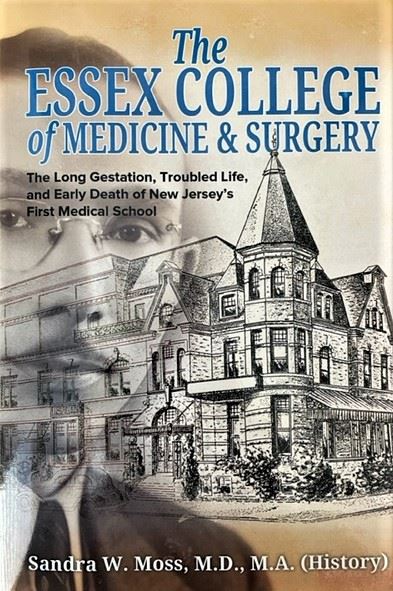 Founded in 1980 |
|
|
Sandra Moss, M.D., M.A.(History), The Essex College of Medicine and Surgery: The Long Gestation, Troubled Life, and Early Death of New Jersey's First Medical School USA, the Author, 2022 ISBN 978-0-692-03766-9 |
Reviewer: Dennis Cornfield, MD / August 14, 2022
It is a peculiar fact that as the middle of the 2oth century approached, the state of New Jersey, with 3 prominent universities (Princeton, Rutgers, and Seton Hall), had no medical school. Numerous "sectarian" (naturopathic, homeopathic, and others) schools had been founded previously, generally disappearing after being recognized as quackeries. Without an established academic medical school with research and a clinical faculty, New Jersey had become mostly an importer of medical knowledge and expertise rather than an exporter.
As stated in the subtitle of her most recent book, The Essex College of Medicine and Surgery, eminent medical historian Sandra Moss, M.D. details "the long gestation, troubled life, and early death of New Jersey's first medical school." The Essex College of Medicine and Surgery was founded in Newark, NJ in September, 1942 by Adolph M. Koch, PhD, the highly educated son of Eastern European Jewish immigrants. Koch was president of Essex Junior College and owner of the college building that was to house the medical school. Koch obtained the license to operate and conduct the medical school from the NJ State Board of Medical Examiners (BME), based on promises of at least sound financial backing, a full medical faculty, and acceptable physical facilities. But adequate funds never materialized, medical faculty came and went, and the facilities were deemed acceptable but marginal. When the school finally opened in January of 1945, it had an acting but not permanent dean, no treasurer, and no chair of Microbiology. It continued to receive short-term provisional approvals by the state's BME, but by the fall of 1945, serious financial irregularities were uncovered. Fraudulent charges were being assessed to many students over and above their tuition as a condition for acceptance into the school. This finding, along with heightened friction among the faculty, the firing or resignation of the
school's dean, and a dearth of funds that had originally been promised by Koch and his backers, led the BME to recommend a complete reorganization of the school's Board of Trustees and a transfer of all power to the new board, an action that Koch and the school undertook only partially. By mid-1946, the state's BME had had enough. With the backing of the AMA, which referred to the school as
"definitely inferior", the BME revoked the school's license, adding that the school had been "crooked" from its inception. The school did not open for the fall session in 1946 and declared bankruptcy in July, 1947.
The Essex College of Medicine and Surgery is extremely well-organized, meticulously researched, and written in a lively, highly-readable style. The chapters, each with its own robust bibliography, are in chronological order. The chapter titles and section headings are themselves often informative enough to cover all the salient upcoming points. The author provides a short Foreward which outlines how the book is organized, starting with the first chapters on attempts to establish some type of medical education in New Jersey between the 18th and early 20th centuries. The bulk of the book, in the author's words, "is an archive-based chronology of the fraught and contentious history of this failed medical college, involving students, faculty, benefactors, administrators, .. " and many other people and entities. There is also an alphabetical guide to individuals and organizations that appear in the book, including a list of the New Jersey-based archives used for the immense amount of research that clearly went into this work.
The down-to-earth, engaging style of writing is one of this book's strongest points. The wording is witty and enlivens events and characters that might otherwise be dull. The author mentions "the fraught rhetorical and regulatory maelstrom that swirled around the Essex College of Medicine and Surgery ... ". She recounts a legal maneuver of Andrew Crummy, the court-appointed co-trustee for the school's reorganization, as his "producing the trump card he had likely been holding in reserve." She describes Herman Blank, the medical students' attorney appearing before the state BME, as "extremely well-prepared, shifting nimbly between 'lap-dog' and 'pit-bull' modes."
I thoroughly enjoyed reading Dr. Moss's book from beginning to end. May I say that it has a beautiful, well-designed cover and feels great in my hands? It is a very informative book and, as suggested by other reviewers on its first page, sheds a lot of light on the regulatory, political, social, and educational milieux in which New Jersey medicine found itself in the 1940's.
Dennis B. Cornfield, M.D.
August14,2022
